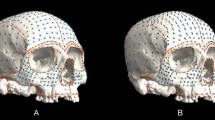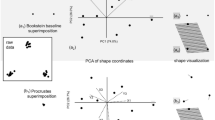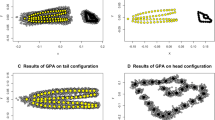Abstract
Studies of morphological integration and modularity are a hot topic in evolutionary developmental biology. Geometric morphometrics using Procrustes methods offers powerful tools to quantitatively investigate morphological variation and, within this methodological framework, a number of different methods has been put forward to test if different regions within an anatomical structure behave like modules or, vice versa, are highly integrated and covary strongly. Although some exploratory techniques do not require a priori modules, commonly modules are specified in advance based on prior knowledge. Once this is done, most of the methods can be applied either by subdividing modules and performing separate Procrustes alignments or by splitting shape coordinates of anatomical landmarks into modules after a common superimposition. This second approach is particularly interesting because, contrary to completely separate blocks analyses, it preserves information on relative size and position of the putative modules. However, it also violates one of the fundamental assumptions on which Procrustes methods are based, which is that one should not analyse or interpret subsets of landmarks from a common superimposition, because the choice of that superimposition is purely based on statistical convenience (although with sound theoretical foundations) and not on a biological model of variance and covariance. In this study, I offer a first investigation of the effects of testing integration and modularity within a configuration of commonly superimposed landmarks using some of the most widely employed statistical methods available to this aim. When applied to simulated shapes with random non-modular isotropic variation, standard methods frequently recovered significant but arbitrary patterns of integration and modularity. Re-superimposing landmarks within each module, before testing integration or modularity, generally removes this artifact. The study, although preliminary and exploratory in nature, raises an important issue and indicates an avenue for future research. It also suggests that great caution should be exercised in the application and interpretation of findings from analyses of modularity and integration using Procrustes shape data, and that issues might be even more serious using some of the most common methods for handling the increasing popular semilandmark data used to analyse 2D outlines and 3D surfaces.





Similar content being viewed by others
References
Adams, D. C. (2016). Evaluating modularity in morphometric data: Challenges with the RV coefficient and a new test measure. Methods in Ecology and Evolution, 7(5), 565–572. https://doi.org/10.1111/2041-210X.12511.
Adams, D. C., & Collyer, M. L. (2016). On the comparison of the strength of morphological integration across morphometric datasets. Evolution, 70(11), 2623–2631. https://doi.org/10.1111/evo.13045.
Adams, D. C., Collyer, M. L., Kaliontzopoulou, A., & Sherratt, E. (2017). Geomorph: Software for geometric morphometric analyses. R package version 3.0.6. https://cran.r-project.org/package=geomorph.
Adams, D. C., Rohlf, F. J., & Slice, D. E. (2004). Geometric morphometrics: Ten years of progress following the ‘revolution.’. Italian Journal of Zoology, 71(1), 5–16. https://doi.org/10.1080/11250000409356545.
Adams, D. C., Rohlf, F. J., & Slice, D. E. (2013). A field comes of age: Geometric morphometrics in the 21st century. Hystrix, the Italian Journal of Mammalogy, 24(1), 7–14.
Baab, K. L. (2013). The impact of superimposition choice in geometric morphometric approaches to morphological integration. Journal of Human Evolution, 65(5), 689–692. https://doi.org/10.1016/j.jhevol.2013.07.004.
Bookstein, F. L. (1991). Morphometric tools for landmark data: Geometry and biology. Cambridge: Cambridge University Press.
Bookstein, F. L. (1997). Landmark methods for forms without landmarks: Morphometrics of group differences in outline shape. Medical Image Analysis, 1, 225–243.
Bookstein, F. L. (2015). Integration, disintegration, and self-similarity: Characterizing the scales of shape variation in landmark data. Evolutionary Biology, 42(4), 395–426. https://doi.org/10.1007/s11692-015-9317-8.
Bookstein, F. L. (2017). A newly noticed formula enforces fundamental limits on geometric morphometric analyses. Evolutionary Biology, 44(4), 522–541. https://doi.org/10.1007/s11692-017-9424-9.
Bookstein, F. L., Gunz, P., Mitteroecker, P., Prossinger, H., Schæfer, K., & Seidler, H. (2003). Cranial integration in Homo: Singular warps analysis of the midsagittal plane in ontogeny and evolution. Journal of Human Evolution, 44(2), 167–187. https://doi.org/10.1016/S0047-2484(02)00201-4.
Cardini, A. (2003). The geometry of the Marmot (Rodentia: Sciuridae) mandible: Phylogeny and patterns of morphological evolution. Systematic Biology, 52(2), 186–205.
Cardini, A. (2013). Geometric morphometrics (in EOLSS encyclopedia of life support systems).
Cardini, A., & Loy, A. (2013). On growth and form in the “computer era”: From geometric to biological morphometrics. Hystrix, the Italian Journal of Mammalogy, 24(1), 1–5.
Cardini, A., & Tongiorgi, P. (2003). Yellow-bellied marmots (Marmota flaviventris)’in the shape space’(Rodentia, Sciuridae): Sexual dimorphism, growth and allometry of the mandible. Zoomorphology, 122(1), 11–23.
Felice, R. N., & Goswami, A. (2018). Developmental origins of mosaic evolution in the avian cranium. Proceedings of the National Academy of Sciences, 115(3), 555–560. http://www.pnas.org/content/115/3/555
Felsenstein, J. (2004). Inferring phylogenies. Sunderland, MA: Sinauer Associates, Incorporated.
Fruciano, C., Franchini, P., & Meyer, A. (2013). Resampling-based approaches to study variation in morphological modularity. PLOS ONE, 8(7), e69376. https://doi.org/10.1371/journal.pone.0069376.
Goswami, A., & Finarelli, J. A. (2016). EMMLi: A maximum likelihood approach to the analysis of modularity. Evolution, 70(7), 1622–1637. https://doi.org/10.1111/evo.12956.
Goswami, A., & Polly, P. D. (2010). Methods for studying morphological integration and modularity. The Paleontological Society Papers, 16, 213–243. https://doi.org/10.1017/S1089332600001881.
Gunz, P., & Mitteroecker, P. (2013). Semilandmarks: A method for quantifying curves and surfaces. Hystrix, the Italian Journal of Mammalogy, 24(1), 103–109.
Klingenberg, C. P. (2008). Novelty and “homology-free” morphometrics: what’s in a name? Evolutionary Biology, 35(3), 186–190. https://doi.org/10.1007/s11692-008-9029-4.
Klingenberg, C. P. (2009). Morphometric integration and modularity in configurations of landmarks: Tools for evaluating a priori hypotheses. Evolution & Development, 11(4), 405–421. https://doi.org/10.1111/j.1525-142X.2009.00347.x.
Klingenberg, C. P. (2011). MorphoJ: An integrated software package for geometric morphometrics. Molecular Ecology Resources, 11(2), 353–357. https://doi.org/10.1111/j.1755-0998.2010.02924.x.
Klingenberg, C. P. (2013a). Cranial integration and modularity: Insights into evolution and development from morphometric data. Hystrix, the Italian Journal of Mammalogy, 24(1), 43–58.
Klingenberg, C. P. (2013b). Visualizations in geometric morphometrics: How to read and how to make graphs showing shape changes. Hystrix, the Italian Journal of Mammalogy, 24(1), 15–24. https://doi.org/10.4404/hystrix-24.1-7691.
Klingenberg, C. P. (2014). Studying morphological integration and modularity at multiple levels: Concepts and analysis. Philosophical Transactions of the Royal Society B, 369(1649), 20130249. https://doi.org/10.1098/rstb.2013.0249.
MacLeod, N. (2008). Understanding morphology in systematic contexts: 3D specimen ordination and 3D specimen recognition. The new taxonomy (pp. 143–210). London: Taylor & Francis Group.
Marcus, L. F. (1990). Traditional morphometrics. In Proceedings of the Michigan morphometrics workshop (Vol. 2, p. 77ą122). Special Publication.
Márquez, E. J. (2008). A statistical framework for testing modularity in multidimensional data. Evolution, 62(10), 2688–2708. https://doi.org/10.1111/j.1558-5646.2008.00476.x.
Mitteroecker, P., & Bookstein, F. (2007). The conceptual and statistical relationship between modularity and morphological integration. Systematic Biology, 56(5), 818–836. https://doi.org/10.1080/10635150701648029.
Mitteroecker, P., & Bookstein, F. (2008). The evolutionary role of modularity and integration in the hominoid cranium. Evolution, 62(4), 943–958. https://doi.org/10.1111/j.1558-5646.2008.00321.x.
Mitteroecker, P., Gunz, P., Windhager, S., & Schaefer, K. (2013). A brief review of shape, form, and allometry in geometric morphometrics, with applications to human facial morphology. Hystrix, the Italian Journal of Mammalogy, 24(1), 59–66.
Nagorsen, D. W., & Cardini, A. (2009). Tempo and mode of evolutionary divergence in modern and Holocene Vancouver Island marmots (Marmota vancouverensis) (Mammalia, Rodentia). Journal of Zoological Systematics and Evolutionary Research, 47(3), 258–267. https://doi.org/10.1111/j.1439-0469.2008.00503.x.
Neff, N. A., & Marcus, L. F. (1980). A survey of multivariate methods for systematics. New York: American Museum of Natural History.
O’Higgins, P. (2000). The study of morphological variation in the hominid fossil record: Biology, landmarks and geometry. Journal of Anatomy, 197(1), 103–120. https://doi.org/10.1046/j.1469-7580.2000.19710103.x.
Oxnard, C., & O’Higgins, P. (2009). Biology clearly needs morphometrics. Does morphometrics need biology? Biological Theory, 4(1), 84–97. https://doi.org/10.1162/biot.2009.4.1.84
R Core Team. (2017). R: A language and environment for statistical computing. Vienna: R Foundation for Statistical Computing.
Rohlf, F. J. (1998). On applications of geometric morphometrics to studies of ontogeny and phylogeny. Systematic Biology, 47(1), 147–158.
Rohlf, F. J. (2000a). On the use of shape spaces to compare morphometric methods. Hystrix, the Italian Journal of Mammalogy, 11(1), 9–25.
Rohlf, F. J. (2000b). Statistical power comparisons among alternative morphometric methods. American Journal of Physical Anthropology, 111(4), 463–478.
Rohlf, F. J. (2003). Bias and error in estimates of mean shape in geometric morphometrics. Journal of Human Evolution, 44(6), 665–683.
Rohlf, F. J. (2015). The tps series of software. Hystrix, the Italian Journal of Mammalogy, 26(1), 9–12.
Rohlf, F. J., & Corti, M. (2000). Use of two-block partial least-squares to study covariation in shape. Systematic Biology, 49(4), 740–753.
Rohlf, F. J., & Slice, D. (1990). Extensions of the procrustes method for the optimal superimposition of landmarks. Systematic Zoology, 39(1), 40–59. https://doi.org/10.2307/2992207.
Schlager, S. (2017). Morpho and Rvcg—Shape analysis in R. In G. Zheng, S. Li, & G. Szekely (Eds.), Statistical shape and deformation analysis (pp. 217–256). London: Academic Press.
Smilde, A. K., Kiers, H. a. L., Bijlsma, S., Rubingh, C. M., & Van Erk, M. J., (2009). Matrix correlations for high-dimensional data: The modified RV-coefficient. Bioinformatics, 25(3), 401–405. https://doi.org/10.1093/bioinformatics/btn634.
Viscosi, V., & Cardini, A. (2011). Leaf morphology, taxonomy and geometric morphometrics: A simplified protocol for beginners. PLOS ONE, 6(10), e25630.
Acknowledgements
I am deeply grateful to Paul O’Higgins for critically discussing with me some of the points presented in this communication, and to Dean Adams for his explanations on some of the methods commonly used in the analysis of modularity and integration. I owe a huge thank to Jim Rohlf for reading the quasi-final version of this paper, and for being most supportive and constructive in his assessment of this work. I am also greatly in debt to David Polly, Carmelo Fruciano and an anonymous reviewer for their in depth assessment of a previous version of this paper, including DP and the anonymous reviewer exploring the issues further using simulations: regardless of agreement or disagreement, all their comments and suggestions greatly improved this preliminary investigation and contributed to showing that there is an issue and that this is definitely more complicated that I originally thought! Last but not least, I wish to dedicate this paper to the memory of Paolo Tongiorgi (1936–2018): Paolo, you have been an extraordinary scientist; the most supportive mentor; a wonderful friend; and the greatest example of generosity I have known in my academic career.
Author information
Authors and Affiliations
Corresponding author
Ethics declarations
Conflict of interest
The authors declare that they have no conflict of interest.
Electronic supplementary material
All simulated datasets are available online as Supplementary Material. Files use the NTS format, commonly employed in morphmetrics, easy to import in MorphoJ or R, and described in details in the help manuals of the TPS Series. The R-script with the simulation by the anonymous reviewer is available upon request; the flaw in the original version is corrected with a single change (to be done for all example datasets): increasing sample size from 100 to 500 in order to avoid most unfavourable p/N ratios and thus low power.
Below is the link to the electronic supplementary material.
Rights and permissions
About this article
Cite this article
Cardini, A. Integration and Modularity in Procrustes Shape Data: Is There a Risk of Spurious Results?. Evol Biol 46, 90–105 (2019). https://doi.org/10.1007/s11692-018-9463-x
Received:
Accepted:
Published:
Issue Date:
DOI: https://doi.org/10.1007/s11692-018-9463-x




